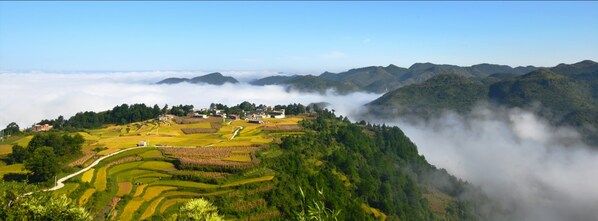BEIJING, April 12, 2023 /PRNewswire/ — A news report from chinadaily.com.cn:
As a Canadian from a rural area, I am always fascinated by the differences between my two homes. My hometown is Mactaquac, New Brunswick, a small village about 30 kilometers outside the provincial capital, Fredericton. My second home is Guiyang, Guizhou province, where I’ve lived for over nine years now.
My hometown is a sleepy place, mostly farms and forest with family homes peppered throughout. As a child, I thought it was boring, but now see the beauty in its peaceful scenery.
The area is a haven for local outdoor enthusiasts. It boasts fishing, skiing, camping, beautiful hiking trails and riverside beaches. Growing up there, I felt isolated. There were almost no shops, few restaurants, and no public transportation to take people around the area. Not much has changed from when I was a child.
There are still no buses, the roads lack sidewalks, and it’s still about a 30-km drive to the nearest supermarket. I love my home, but what we have in natural beauty, we pay for with a nearly complete absence of conveniences.
Living in Guiyang, it is exciting to be able to take advantage of city life. There are so many restaurants, shopping malls and lively crowds. There’s convenient access to everything I need.
When I need to get away from the city life, it’s a quick drive to peaceful villages and beautiful scenery. I visited Gaopo township for the first time this year and was struck by the similarities and differences to my hometown. Like my hometown, Gaopo is not far from the provincial capital, and draws visitors who love the outdoors.
Before visiting, I had seen gorgeous photos of the mountains, and people camping and hiking. Gaopo is much bigger than Mactaquac, but it still has the warm, rustic feel of village life. Clean, white houses line the roads, and it’s clear that the area is full of life and industry.
There are farms all over Gaopo. The agriculture of the area is clean, modern and varied. Upon my return, I learned that the area grows all sorts of fruits and vegetables, branching out significantly from the more traditional crops, corn and rice, grown in the area.
Plums, peaches, pears, blueberries, asparagus, and more dot the fields and valleys. Mushroom and flower cultivation are also increasing. These higher value crops allow farmers to earn more for their work and increase the income of the villages. Wet markets were bursting with local produce, providing residents with fresh and affordable food. The mountains are covered in terraced farms, a testament to the fact that the people are not afraid of hard work. With the assistance of scientists and modern technology, Gaopo’s agricultural industry is set for growth.
Gaopo township is clearly undergoing great changes, but the area retains its natural beauty.
The mountains seem like untouched nature. If you look closer, though, it is clear that there are environmental protection measures in place. On top of a mountain, I spotted a group of people planting trees and realized that the other mountain’s regular rows of new-growth forest had also been intentionally planted.
The local spring-water sources were marked as protected. Stone walls guarded the mountains against erosion where it was likely to be caused by flowing springs, small waterfalls or steep mountain sides. The mountain tops were also lined with wind turbines, providing clean energy for the area.
My visit showed me what the combined efforts of a village can do. Through the local revitalization efforts, Gaopo has grown into a modern township.
The conveniences I long for in my hometown are found everywhere in Gaopo.
There are markets, restaurants, schools and public transportation, and they all exist alongside a booming agricultural and tourism industry. People are drawn from all over the country to see the beautiful mountain scenery of the area.
They may be unaware of the great changes taking place in the local agricultural industry or the careful planning that keeps the area beautiful for their enjoyment.
They do, however, get to take advantage of the painstaking work of the people of Gaopo when they visit. I hope this work continues, and that the people of the area continue to reap the rewards and that more visitors can see the transformation for themselves.
















